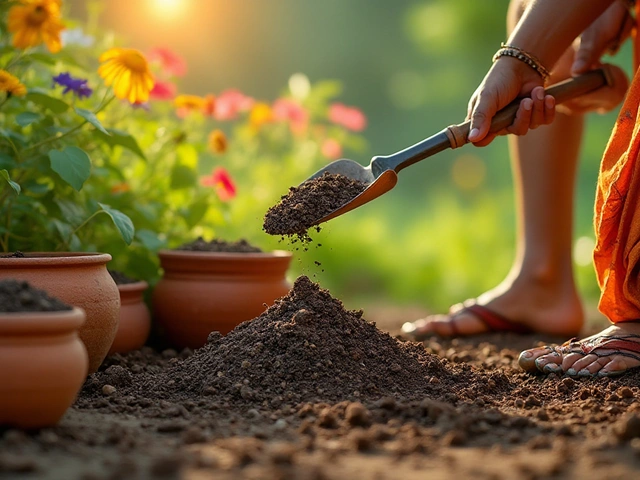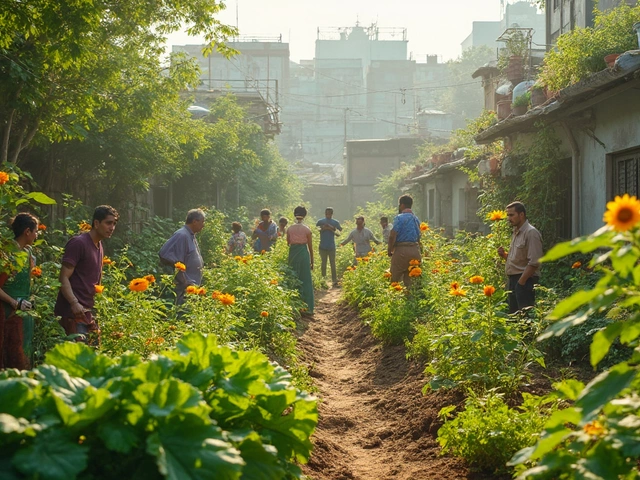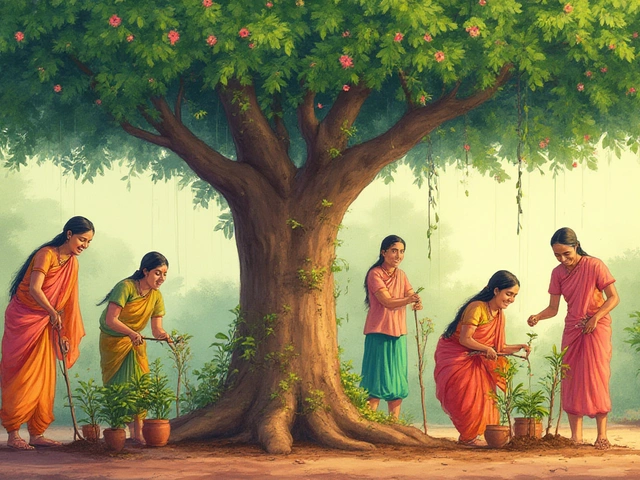Ever wonder why some people’s tomatoes look like they bench press and yours can barely stand up straight? It almost always comes down to what’s happening under the surface—in the soil. Tossing seeds into random dirt rarely works as well as folks hope. The truth is, garden soil needs a little extra love if you want those epic salads and sandwiches straight from your backyard.
Before you dump anything into those garden beds, grab a handful of your soil. Is it sticky like dough, powdery and dry, or does it turn to cement when wet? Getting familiar with your soil’s personality saves you money and prevents problems down the line. Once you know what you’re working with, adding the right stuff can actually turn things around—without endless trial and error.
- Understanding Your Current Soil
- Organic Additions for Healthier Soil
- Fixing Common Soil Problems
- Ongoing Care and Simple Tips
Understanding Your Current Soil
Think of your soil as the foundation of your vegetable garden. If the base isn't solid, nothing you plant is going to do its best. Plenty of folks skip straight to adding fancy stuff, but you want to know what you're dealing with first. Not all dirt is the same, and jumping in blind can end up costing you a lot of wasted time and effort.
The classic soil types are sand, silt, clay, and loam. Each has its own quirks:
- Sand: Drains fast, but won't hold nutrients well.
- Silt: Silky and powdery, decent for holding water but can get compact.
- Clay: Feels sticky, super dense, keeps nutrients but is slow to drain.
- Loam: The holy grail – crumbly, dark, and just right for most veggies.
A simple test? Grab a handful of moist soil and squeeze. If it stays clumped but crumbles easily, you probably have loam. If it breaks apart too fast (sandy) or stays like a lump of modeling clay (clay), you’ll want to tweak your approach.
Getting more technical, a soil test can tell you what’s missing or too high. Home test kits are cheap, and they give you numbers for pH, nitrogen, phosphorus, potassium, and sometimes even organic matter. Here’s a quick rundown of what veggies like:
| Soil Feature | Ideal Range for Veggies |
|---|---|
| pH | 6.0 – 7.0 |
| Nitrogen | Medium to High |
| Phosphorus | Medium |
| Potassium | Medium |
| Organic Matter | 5% or above |
If your pH is way off, your plants won’t use nutrients, no matter how much you add. Too much clay? Most roots will struggle. Too sandy? Get ready to water nonstop. That’s why checking the basics makes all the difference when you’re aiming for rich, productive vegetable garden soil.
Organic Additions for Healthier Soil
If your garden soil feels lifeless, don’t stress—there’s an easy fix. Adding the right organic stuff can wake up tired dirt, making it perfect for veggies. By far, compost is the top choice. Homemade compost made from food scraps, grass clippings, and leaves gives your plants a big boost. Spread about two inches over your garden and mix it in each spring. This keeps your soil rich and loose, and it also attracts earthworms (your garden’s free workforce).
Aged manure is another classic move. Cow, horse, or chicken manure adds nutrients, but only after it’s broken down over time. Never use the fresh stuff—it’s just too strong and can burn roots. Pick up bagged composted manure from your local garden center if you don’t have access to local farms.
Worm castings hit different, too. These tiny worm droppings are loaded with easy-to-absorb nutrients. Mix a couple of handfuls per square foot into your beds. People call this stuff “black gold” for a reason.
- Vegetable garden pros will tell you: skip the shortcuts and add plenty of shredded leaves, chopped straw, or untreated grass clippings as mulch. It helps the soil hold moisture, and all that organic matter just turns into plant food over time.
- Don’t forget peat moss or coconut coir if your soil is clay-heavy or sandy—they help with texture and water holding, though they don’t feed your plants much on their own.
- For bonus points, try cover crops like clover or vetch in the off-season. They crowd out weeds and add nutrients when you dig them in before planting.
Bottom line—stack your soil with stuff that breaks down naturally. It creates a steady trickle of nutrients, helps hold water, and builds the home base your veggies need to thrive.

Fixing Common Soil Problems
Even the healthiest-looking dirt can have issues that mess with your vegetable garden dreams. Most backyard gardeners run into the same three: soil that’s too clay-heavy, too sandy, or missing good nutrients. Fixing these takes a bit of elbow grease, but you’ll reap the rewards at harvest time.
If your soil is sticky, clumps together, and water just sits on top—it’s full of clay. Veggies hate soggy feet, and clay suffocates their roots. The way out? Add organic stuff like compost, rotted leaves, or even coconut coir. This helps break up the clumps and lets water and air move around. Skip sand as a fix—it can turn your garden into something closer to concrete.
Got the opposite problem? Sandy soil drains so fast, water and nutrients skip town before your plants can grab them. You want more sponge-like texture, so dump in compost, worm castings, or peat moss. These act like a water magnet and help sandy soil hold on to food for your veggies.
Now if your veggies look sad and yellow, or just don’t grow—chances are your soil is running low on something crucial. Nitrogen, phosphorus, and potassium are the big three for plant growth. Here’s a table so you can spot what might be missing based on what your plants are telling you:
| Problem | Clue | What to Add |
|---|---|---|
| Slow growth, yellow leaves | Lack of nitrogen | Compost, blood meal, fish emulsion |
| Weak roots, small fruits | Lack of phosphorus | Bone meal, rock phosphate |
| Weak stems, poor resistance | Lack of potassium | Wood ash, greensand, kelp meal |
Testing your soil with a simple home kit saves you from playing a guessing game. If you find your pH is off (you want somewhere near 6.0-7.0 for most veggies), adjust with lime (to raise pH) or sulfur (to lower it). Don’t just chuck in fertilizers at random—you might turn a small problem into a big one. Target what your vegetable garden actually needs, and you’ll see a real difference.
Ongoing Care and Simple Tips
Keeping your vegetable garden soil in good shape isn’t just a one-time thing. Even after you’ve mixed in compost or fixed your pH, your soil still needs a bit of attention every season if you want repeat harvest wins instead of disappointment.
Think of your garden as a low-key pet. Feed it, check it over, and make quick fixes before things get out of hand. Here’s what works best to keep that soil healthy year after year:
- Top up your compost every season: Spread a 1-2 inch layer on your beds in early spring or late fall. This feeds the soil and keeps it loose.
- Rotate your crops: Don’t plant tomatoes in the same spot every year. Changing things up helps prevent disease and keeps nutrients balanced.
- Watch your moisture: Dry spells show up fast in veggie beds. Stick your finger in the ground—if it’s dry past your knuckle, it’s time to water.
- Cover up: Add mulch like straw, shredded leaves, or even grass clippings around your veggies. This stops weeds, keeps moisture in, and adds organic matter as it breaks down.
- Test, but don’t stress: Do a soil test every couple of years. Home test kits from the garden center will tell you if you’re low on basics like nitrogen, phosphorus, or potassium.
Here’s a quick look at some basic ongoing care and how often to do each one:
| Task | How Often | Tip |
|---|---|---|
| Add compost | Spring/Fall | Use finished, not smelly, compost |
| Mulch beds | Every summer | 2-3 inches thick is enough |
| Rotate crops | Every season | Group by plant family |
| Test soil | Every 2-3 years | Look out for pH changes |
| Pull weeds | Weekly | Don’t let them set seed |
One last tip: resist the urge to dig deeply every year. Heavy digging breaks up healthy soil networks and earthworm tunnels. If you stick to light turning and focus on adding good stuff on top, your soil will just keep getting better.





